ISSN: 1204-5357
ISSN: 1204-5357
| Malek Al-Majali Assistant professor of Marketing at College of Business Administration, Mu’tah University Author's Personal/Organizational: www.mutah.edu.jo Email: Drmalekalmajali@yahoo.com Dr. Al-Majali is an expert in E-marketing and E-commerce, E-consumer behaviour and marketing research. Other fields of experience include Structural Equation Modeling (SEM) analysis, Statistical Package of Social Sciences (SPSS) analysis, Internet Business and Marketing and researching. |
Visit for more related articles at Journal of Internet Banking and Commerce
Internet Trading Service “her after called” (ITS) is an information intensive business that has become a major trend in the financial marketplace nowadays. It is important to understand what predictors will impact the customer’s attitude toward using ITS in Jordan. This paper is concerned with an empirical investigation of the factors that could predict customer’s attitude toward using of ITS in Jordan through applications of Innovation Diffusion Theory (IDT). The research model consists of six exogenous variables: perceived usefulness, perceived ease of use, compatibility, trialability, trust and awareness and one endogenous variable: attitude toward using of ITS. 300 questionnaires survey among university staff was implemented and 265 data sets were collected. This represents 88% response rate. After rigorous data screening process such as outliers, normality, reliability and validity, 227 data is ready for structural equation modeling (SEM) analysis. Confirmatory Factor Analysis (CFA) was performed to examine the composite reliability, convergent validity and goodness of fit of individual construct and measurement models. The revised structural model demonstrates significant and positive direct relationships between all of six exogenous variables and ITS.
Keywords |
| Internet Trading Service, customer’s attitude, trust and awareness |
INTRODUCTION |
| The Internet revolution has been changing the fundamentals of our society. It shapes the way we communicate and the way we do business. It brings us closer and closer to vital sources of information (Ramayah, Rouibah, Gopi, Gary and Range, 2009). It provides us with means to directly interact with service-oriented computer systems tailored to our specific needs. |
| In the old days, because of the limitations of communications technology, Wall Street was the center for most of the stock exchange and brokerage firms. Today, at this millennial transition, investors can use revolutionary Internet Client-Server technology to trade stocks nearly anywhere, anytime, independent of brokers' fees and service limitations (Rapeeporn, Paul and Himangshu, 2002). This new access by the trading public to low-cost transactions and cutting-edge, real-time market information that formerly belonged only to brokers has opened up extraordinary new investment opportunities as well as a crucial need for state-of- the-art information (Teo, Tan and Peck, 2004). |
| The mechanism of the ITS starts with the investor selecting a brokerage firm licensed by the stock exchange to provide the internet trading services ( Loh and Ong, 2010). Once all the required procedures have been fulfilled to open the account, the agreement has been signed, the risk statement has been reviewed, the clients get the user name and the password to activate their account with the broker and enable them to use it solely by themselves. Then the clients start to enter their own orders and follow-up their execution directly. |
| The Users of ITS need to realize some important issues; namely, confidentiality of investors accounts activities in order to dismiss and avoid any probability of outsider intrusion which might cause or result of blocking the service messages, or accessing to the user's computer( Loh and Ong, 2010). Also they need to realize the importance of familiarity with the mechanism of operation and the software functions used to run the internet trading service. In addition, users must know how to handle cases when the system breaks down due to any damages to the internet; which might be barring the investors from interacting with the orders they enter into the internet trading system(Ramayah, Rouibah, Gopi, Gary and Range, 2009). Also users of the service need to review the risk disclosure statement attached to the agreement that the users have to sign with the broker, they also need to review and understand the software user manual; investors also need to learn of the emergency plan provided by the broker which enables the investors to communicate with the broker to follow up the entered orders in case of interruption of the service for any reason (Teo, Tan and Peck, 2004). |
| Using the ITS properly, trying to avoid risks of the service and following guidelines of the brokerage firm; the service will provide a great benefit as it enables investors to watch the trading information live and follow up the trading session proceedings and make the investment decisions immediately making use of the investment opportunities once they are available (Looney, 2002), since this service does not require the client's presence at the brokerage firm premises; nor to make a phone call with them, the clients just need to enter the buy or sell order through the software used for the service, then the order enters the electronic trading system, after the order's fulfillment of requirements gets electronically verified by the broker's systems (Teo, Tan and Peck, 2004; Looney, 2002). It is worth mentioning that this service enables investors to follow up the executions of their orders and managing their investment portfolio directly and at any time. Moreover, ITS will give the broker an opportunity to attract a large number of new investors whether they are local or foreigners considering the benefits that investors will gain by using this service, consequently, the trading revenues of the broker will increase due to the increased activities of the new service((Looney, 2002; Rapeeporn, Pauland and Himangshu , 2002). Moreover, the service will help save time, cost, and effort compared with the traditional method. Moreover the brokers will be able to assume their major role of analyzing securities and studying the price movement to advise the clients rather than getting involved in entering orders on behalf of clients (Rapeeporn, Pauland and Himangshu , 2002). |
| In recent years, understanding why the investors accept or reject computer systems such as ITS has proven to be one of the most challenging issues in information system research especially in Jordan. Besides, the limited of empirical studies related using ITS in Jordan. This gap makes it necessary to have more empirical studies on predictors of ITS. Furthermore, Previous international ITS research has focused on developed countries particularly Europe and northern America, while Jordan (the Middle Eastern region) has been neglected despite recent changes in its technological and economic regulatory environments. Therefore, Understanding the factors such as perceived usefulness, perceived ease of use, compatibility, trialability, trust and awareness, which influence Jordan’s toward using ITS practices, disclosures and documenting their impact takes on a particular importance at this time of change and growth. |
| This paper, therefore, fills a gap in ITS research. It explores key predictors of ITS and links them to the development of ITS regulation in Jordan. Our study examines how these predictors influenced using of ITS in Jordan. This study intends to investigate six predictors of customers attitude toward using of ITS using Diffusion of Innovation (DOI) model to enhance the quantitative studies using Structural Equation Modeling (SEM) to analyze set of predictors of customers attitude toward using of ITS. |
LITERATURE REVIEW |
| The research framework of this study is based on the adaptation of Diffusion of Innovation Theory (DOI) first developed by Rogers (1983) (Figure 1). DOI suggests five key beliefs (relative advantage, compatibility, complexity, trialability, and observability) that could influence individuals to adopt an innovation. Relative advantage is defined as “the degree to which an innovation is perceived as being better than the idea it supersedes”. In other words, the concept of relative advantage is similar to the concept of perceived usefulness (Moore and Benbasat, 1991; Taylor and Todd, 1995). According to Rogers (1983), relative advantage requires the adopter to analyze the costs and benefits of using an innovation, which can be expressed economically, socially, or in other ways. Is argument, this study replaces relative advantage with perceived usefulness. Based on Compatibility is defined as “the degree to which an innovation is perceived as consistent with the existing values, past experiences, and the needs of potential (p. 224).” Compatibility is evaluated relative to the adopter’s sociocultural values and beliefs, previously introduced ideas, and client needs for innovation. Difficult to understand and use (p. 242), Trialability is defined as “the degree to which an innovation may be experimented with on a limited basis (p. 243).” Trialability allows individuals to “test drive” an innovation before it is being adopted. Both compatibility and trialability will be used as it is for this study. Complexity reflects the level of physical or mental efforts necessary to use an innovation. Accordingly, complexity is the opposite of perceived ease of use (Moore and Benbasat, 1991; Taylor and Todd, 1995). Thus perceived ease of use replaces complexity). The final belief in DOI is observability, which is defined as “the degree to which the results of an innovation are visible to others.” But this factor was excluded for this study mainly due to the nature of the targeted technology chosen i.e., ITS. We feel individuals typically do banking transactions privately. The acts are not observable and visible to others (Tan and Teo, 2000). |
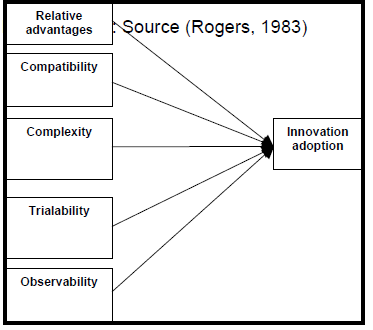 |
RESEARCH FRAMEWORK |
| As discussed above, our research framework proposed for this study is not exactly the same as the DOI model (Figure 2). Besides maintaining four of the DOI variables, two more variables were added i.e. trust and awareness. This is so because several past studies have found that the perceived trust and awareness have found significant relationship with diffusion of any innovation. The following literature review will explain each linkages and gaps further. |
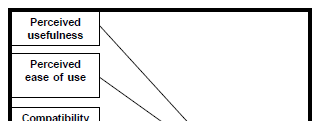 |
Definition of attitude |
| Based on TRA, attitude is the first antecedent of individual intention to perform (Ajzen and Fishbein, 1975). Attitude toward behaviour reflects the estimation of positive or negative feeling to certain behaviour. Hence, this construct depends on whether it is positively or negatively estimated (Ajzen and Fishbein, 1980). |
| According to Ajzen (1991, p. 188), attitude is defined as: |
| ‘‘The degree to which a person has a favorable or unfavorable evaluation or appraisal of the behaviour in question’’. |
| The individual attitudes tend to arise from certain salient beliefs, and therefore these beliefs are said to be immediate antecedents of a person’s attitude (Ajzen, 1991). Moreover, attitude toward a behaviour is treated to be a function of one’s salient beliefs that represent the perceived consequences of the behaviour and a person’s favorable attitude toward a specific behaviour strengthens his/her desire to do the behaviour (Ajzen, 1991). In addition, obtaining favorable or unfavorable attitudes toward the object depends on whether the object is associated with positive or negative characteristics (Ajzen and Fishbein, 2000). |
Predictors of attitude |
| TRA and its extension TPB have been used to predict and explain a wide range of behaviours in terms of a limited set of constructs (Ajzen, 1991). In those theories, the salient beliefs were accorded an important role. Salient behavioural beliefs (beliefs about the consequences of performing the behaviour) are held to determine attitude toward the behaviour (Ajzen, 1991). Therefore, attitude is an individual’s salient belief as to whether the outcome of his/her behaviour will be positive or negative. Hence, when a customer has positive salient beliefs about his/her behaviour, he/she will have positive or negative attitude to perform the behaviour (Ajzen and Fishbein, 2000). |
Perceived usefulness |
| Davis (1989) defines perceived usefulness as ‘‘the degree to which an individual believes that using a particular system would enhance his/her job performance’’. Perceived usefulness can be defined as: |
| Figure 2: Research Framework |
Definition of attitude |
| Based on TRA, attitude is the first antecedent of individual intention to perform (Ajzen and Fishbein, 1975). Attitude toward behaviour reflects the estimation of positive or negative feeling to certain behaviour. Hence, this construct depends on whether it is positively or negatively estimated (Ajzen and Fishbein, 1980). |
| According to Ajzen (1991, p. 188), attitude is defined as: |
| ‘‘The degree to which a person has a favorable or unfavorable evaluation or appraisal of the behaviour in question’’. |
| The individual attitudes tend to arise from certain salient beliefs, and therefore these beliefs are said to be immediate antecedents of a person’s attitude (Ajzen, 1991). Moreover, attitude toward a behaviour is treated to be a function of one’s salient beliefs that represent the perceived consequences of the behaviour and a person’s favorable attitude toward a specific behaviour strengthens his/her desire to do the behaviour (Ajzen, 1991). In addition, obtaining favorable or unfavorable attitudes toward the object depends on whether the object is associated with positive or negative characteristics (Ajzen and Fishbein, 2000). |
Predictors of attitude |
| TRA and its extension TPB have been used to predict and explain a wide range of behaviours in terms of a limited set of constructs (Ajzen, 1991). In those theories, the salient beliefs were accorded an important role. Salient behavioural beliefs (beliefs about the consequences of performing the behaviour) are held to determine attitude toward the behaviour (Ajzen, 1991). Therefore, attitude is an individual’s salient belief as to whether the outcome of his/her behaviour will be positive or negative. Hence, when a customer has positive salient beliefs about his/her behaviour, he/she will have positive or negative attitude to perform the behaviour (Ajzen and Fishbein, 2000). |
Perceived usefulness |
| Davis (1989) defines perceived usefulness as ‘‘the degree to which an individual believes that using a particular system would enhance his/her job performance’’. Perceived usefulness can be defined as: |
| “The extent to which a person believes that using the system will enhance his/ her job performance” (Davis, 1989, p. 320). |
| The perceived usefulness of something is its ability to offer a means-end relationship or to offer a rationale upon which to create decisions. Means-end knowledge accounts for why customers utilize a product (Barczak, Ellen and Pilling, 1997). |
| According to Shrivastava (1987) the perceived usefulness of the knowledge a person gains depends on how that knowledge can be practiced in an exacting decision-making condition and is dependent upon the perceived meaningfulness of the particular knowledge, the perceived relevance of the goal, the perceived operational validity and the perceived innovativeness. |
| The significance of the perceived usefulness relies on the fact that it is one of the factors that influence the clients’ attitudes towards acceptance/using/adopting the new technology (Suh and Han, 2002). The relationship between usefulness and attitude has established mixed findings. Most of the previous studies found positive significant linkages (Pikkarainen, Pikkarainen, Karjaluoto and Pahnila, 2004; Eriksson, Kerem and Nilsson, 2005; Yiu, Grant and Edgar, 2007; Gounaris and Koritos, 2008; Ozdemir and Trott, 2009), while one study found insignificant effect (Yu and Lo, 2006). Hence, this study hypothesizes positive linkage as follows: |
| H1. Perceived usefulness has significant and positive influence on customer attitude toward using ITS. |
Perceived ease of use |
| Perceived ease of use implies that accessible routines can be practical to the condition at hand. In such a case, there will be no awareness of uncertainty (Eriksson and Sharma, 2003), in that routines require not be distorted to give up an outcome that is at least acceptable (Nelson and Winter, 1982). Furthermore, the perceived ease of use may be inferior if the routines are inappropriate for the condition. Then the company will have to expand and learn new routines that better costume the condition (Davis, 1989). |
| “The extent to which a person believes that using the system will be free of effort”. |
| Davis (1989) indicates that the client will be more willing to adopt the new technology, when he perceives the ease of its use. Other researchers such as Doll and Torkzadeh (1988) showed that the higher the degree of revelation in the information, the less is its use: meaning that the more standardized and easy to get to the market information, the more useful it is, because the last kind of knowledge requires less learning by the firm. Additionally, several past studies discussed this relationship in different technological settings, such as the mobile online services, education online services, and e-filling of tax system, online purchase services and other new technology services. |
| Davis (1989) defines perceived ease of use as ‘‘the degree to which an individual believes that using a particular system would be free of physical and mental effort’’. In different technological context perceived ease of use appears as important factor was employed in several of past studies. But these past studies had been presented the relationship between perceived ease of use and attitude as inconsistent result, for example this relationship found to be significant effect on IBSA in past studies related to (Sohail and Shanmugham, 2003; Yu and Lo, 2006; Yiu, Grant and Edgar, 2007; Gounaris and Koritos, 2008; Ozdemir and Trott, 2009). On other hand, this relationship was found to be insignificantly (Eriksson, Kerem and Nilsson, 2005; Hernandez and Mazoon, 2007; Pikkarainen, Pikkarainen, Karjaluoto and Pahnila, 2004). Hence, this study hypothesizes positive linkage as follows: |
| H2. Perceived ease of use has significant and positive influence on customer attitude toward using ITS. |
Compatibility |
| Compatibility is considered one of the main determinants for the innovation spread process- with the high compatibility perceived by the individual leading to the speedy adoption of any new ideas or technologies (Rogers, 1983: 1995). |
| According to (Rogers, 1983 p.224), compatibility is defined as: |
| “The degree to which an innovation is perceived as being consistent with the existing values, needs, and past experiences of potential adopters”. |
| McQuail (2005) showed compatibility as the consistency between the new innovations and the user’s values, beliefs, ideas and needs. Moreover, Tornatzkey and Klein (1982) indicated that an innovation is more likely to be adopted when it is compatible with the job responsibilities, value system and belief of the individual. Therefore, it may be predictable that compatibility relates significantly to adoption, because of the higher compatibility that is perceived by an individual will upgrade the speed for adopting new ideas or new object Rogers (1995). Several of researchers shows that the compatibility as one of the main determinants for the innovation spread process with the high compatibility perceived by the individuals leads to the speedy adoption of any new ideas or technologies. This relationship has established mixed findings. Most of the previous studies found positive significant linkages and found that the compatibility significantly effect on customers attitude toward actual usage (Kolodinsky and Hilgert, 2004; Hernandez and Mazoon, 2007; Eriksson, Kerem and Nilsson, 2008). While, other studies found that the compatibility effects insignificant on customers attitude toward actual usage related to (Gounaris and Koritos, 2008; Nor and Pearson, 2007; Shih and Fang, 2004; Taylor and Todd, 1995). Hence, this study hypothesizes positive linkage as follows: |
| H3. Compatibility has significant and positive influence on customer’s attitude toward using ITS. |
Trialability |
| Rogers (1995) argues that when potential adopters are allowed to try an innovation, they will feel more comfortable with the innovation and are more likely to adopt it. Additionally, Tan and Teo (2000) show that if the customers are given the opportunity to try the innovation certain fears of the unknown may be reduced. This is especially true when customers find that mistakes could be rectified, providing a predictable situation (Nor and Pearson, 2007). According to Rogers (1983, p. 243), trialability is defined as: “The degree to which an innovation may be experimented with on a limited basis, which allows individuals to “test drive” an innovation before it is being adopted”. |
| This factor is supposed to allow the potential users to try the innovation first; which contributes to achieving some sort of comfort among the customers and the users who may later become more willing to adopt this innovation (Rogers, 1983; 1995). Previous studies indicate that if the user got the chance to try the new technology, this would lessen his feelings of fear concerning the usage of this technology (Tan and Teo, 2000). The relationship between trilability and attitude was found to inconsistency. However, The Trialability was found significant effect on customers attitude in past studies related to (Hernandez and Mazoon, 2007). Also this relationship was found to be insignificant effect on customer’s attitude in others (Duda, Santhapparaj, Asirvathem and Raman, 2007). Hence, this study hypothesizes positive linkage as follows: H4. Trialability has significant and positive influence on customer’s attitude toward using ITS |
Perceived trust |
| Trust is an important factor in many social activities, involving uncertainty and dependency (Pavlou and Fygenson, 2006). Also, it is central to any economic activity, whether conducted in a retail outlet in the actual offline world or in excess of the internet, and is still more important in an online situation (Gefen, Karahanna and Straub, 2003; Gefen and Straub, 2004). One main reason for the importance of trust in e-commerce activities is the fact that in a virtual setting the degree of uncertainty of economic transactions is higher than in traditional settings (Rotchanakitumnuai and Speece 2007). |
| According to Moorman, Deshpande and Zaltman (1993) trust is defined as: |
| “The perceived credibility and benevolence of a target of trust”. |
| The consumers’ trust in their online activities is very important, and has been identified as a key to the development of e-commerce (Suh and Han, 2002). According to Alsajjan and Dennis (2006), the concern of trust is more important in online as opposed to offline banking. From the literature we fond that the relationship between perceived trust and customers attitude has established mixed findings. Several of past studies found that the relationship between perceived trust and customer’s attitude was significantly effect (Liao and Cheung, 2002; Sohail and Shanmugham, 2003; Eriksson, Keremand Nilsson, 2005; Yu and Lo, 2006). Alternatively, Duda, Santhapparaj, Asirvathem and Raman (2007) found that the perceived trust positively effect on customers attitude but is not significantly. Hence, this study hypothesizes positive linkage as follows: |
| H5. Trust has significant and positive influence on customer’s attitude toward using ITS. |
Awareness |
| Rogers (1983) defined awareness of innovation as: |
| “Individual is exposed to the innovation’s existence and gains some understanding of how it functions”. |
| While Sathye (1999, p. 325) has defined awareness of innovation as: |
| “Understanding whether the customer is aware or not aware of the service itself and its benefits”. |
| In this manner, the adoption or rejection of any new technological innovations starts with the clients’ awareness of these innovations (Rogers, 1983). So, several researchers reveal that the customer’s awareness-knowledge of new technology is one of the more important factors influencing the adoption or acceptance of any innovative service or product. For example, Howard and Moore (1982) suggested that consumers must be aware of the new brand before actual adoption. |
| In addition, Suganthi, Balachandher and Balachandran (2001) assert the importance of awareness for the adoption of any innovation. Furthermore, increasing the awareness levels of innovation of e-commerce among users has been identified as a major catalyst to encourage the adoption of online technologies and is necessary to develop expertise in online technologies to form ‘smart’ communities and be more competitive in the global marketplaces. |
| The previous empirical studies in internet banking area found that awareness of the benefits and advantages of internet banking service will influence significantly on the customers to adopt this service (Sohail and Shanmugham, 2003). From the dissections above we observe that the relationship between awareness and customer’s attitude has inconsistent or mixed results. |
| Hence, this study hypothesizes positive linkage as follows: |
| H6. Awareness has significant and positive influence on customer’s attitude toward using ITS. |
| From the literature discussion above, we found that the six constructs (perceived ease of use, perceived usefulness, compatibility, trilability, trust, awareness) have a significant direct impact on customers attitude mostly, but there are limited empirical studies found that these constructs insignificant effect on customer’s attitude toward ITS. However, these prior studies on technology innovation adoption factors have produced mixed results, which have culminated to the difficulty in articulating the customer’s attitude toward using ITS drivers. |
METHODOLOGY |
| This is a field study consisting mainly quantitative approach to research. The unit of analysis is Amman Stock Exchange investors and those who are interested in ITS in Jordan. |
Questionnaire design and measurement scale |
| The questionnaire for this study consists of three parts: Part one consists of a cover letter explaining title of the research and the purpose of this questionnaire; Part two consists of demographic questions about the respondents demographic profile; and finally Part three contains the seven latent constructs that are hypothesized to influence customer’s attitude toward using ITS in Jordan totaling thirty (30) items. These constructs were adapted from previous studies thus, exploratory factor analysis is omitted. The measures are (1) attitude toward using ITS measured by six items (Taylor and Todd, 1995); (2) perceived usefulness measured by six items adapted from Lai and Li, (2005); (3) perceived ease of use measured by four items adapted from Ho and Ko, (2008); (4) compatibility measured by six items adopted from Nor and Pearson, (2007); (5) trialability, measured by six items adapted from Nor and Pearson, (2007); (6) trust measured by six items adapted from Suh and Han, (2002); and finally (7) awareness measured by four items adapted from Al-Somali, Gholami and Clegg, (2009). Sevenpoint Likert scale with anchors from (1) strongly disagree to (7) strongly agree respectively, was used for all items. |
Sample of study |
| To examine the predictors that could influence customer’s attitude toward using ITS in Jordan, the sample (investors) was taken randomly from telephone directories of the ten selected company in Amman Stock Exchange in Jordan. The survey was conducted from the 1st of August to the 1st of October 2011 (around eight weeks). The researcher distributed three hundred (300) questionnaires to the respondents who returned 265 of the questionnaires while thirty five (35) questionnaires were unreturned. Another 23 questionnaires were incomplete leaving two hundred forty two (242) questionnaires for further analysis or 80% response rate. |
Data screening and analysis |
| The 242 dataset were coded and saved into SPSS version 15.0 and analyzed using AMOS version 6.0. The data were carefully examined for missing data. It was discovered that thirteen (13) questionnaires or 5.2 percent have missing responses. However, the missing cases were treated with replacement of mean so none was deleted. This method is considered to be viable by several scholars (e.g. Hair et al., 2006). Next, inspection of Mahalanobis distance (D2) was conducted to identify outlier cases. Outlier result shows that 15 dataset were deleted due to D2 values greater than χ2 value. For univariate normality test, Z-skewness scores greater than +3 or -3 were absent. Thus, each item is considered to be normal data (Coakes and Steed, 2003). Thus, only two hundred twenty seven 227 questionnaires remain for final analysis. |
| Subsequently, several statistical validity tests were then conducted such as reliability test, composite reliability tests, confirmatory factor analysis (CFA) for construct convergent validity, discriminate validity for multicollinearity treatment, descriptive analysis and correlation. Hereafter, Structural Equation Modeling (SEM) analysis using AMOS 6.0 was conducted. SEM is selected because SEM using confirmatory factor analysis to minimize measurement error through to the multiple indicators per –latent variable, ability to estimate both direct and indirect effects, and a testable model and ability to ensure consistency of model with data and to estimate effects among constructs. The SEM analysis produces three structural models namely hypothesized structural model, revised model and competing model. |
FINDINGS |
Demographic profile of the respondents |
| Most of the respondents were male (73.7%) compared to female (26.3%). This is expected in a male dominant country like Jordan. Their ages range from 31 to 40 years. About 80% of respondents were married, the majority (73.9%) lives in the Jordanian cities and about 40% have a Bachelor degree. About 55% work at managerial level in the university and more than half (57.4%) of respondents have salaries between 501- 1000 JD. On the usage of internet technology, 63% have used the internet technology for period of 6-10 years. |
Descriptive statistics of variables |
| Table 1 indicates that the seven constructs, six exogenous (perceived ease of use, perceived usefulness, compatibility, trilability, trust, awareness) and one endogenous (AVSE) have both Cronbach alpha and composite reliability of above 0.60. This implies that the measurement scales for all variables are internally consistent and reliable (Nunnally, 1970). |
 |
Confirmatory factor analysis (CFA) results |
| From the confirmatory factor analysis result in Table 2, we observed that the factor loadings of all observed variables or items are adequate, ranging from 0.38 to 0.92. In this study, the "cut-off" point chosen for significant factor loading is 0.30, the minimum level required for a sample size of 350 and above as suggested by (Hair et al. 2006, p 128). This indicates that all the constructs conform to the convergent construct validity test. As shown in Table 2, the remaining numbers of items for each construct are as follows: ITS (4 items), perceived usefulness PU (4 items), perceived ease of use PEOU (4 items), compatibility COM (4 items), trilability TRIL (5 items), trust (TRUS) (4 items), awareness (AWAR) (3 items) and total item remaining is 28. |
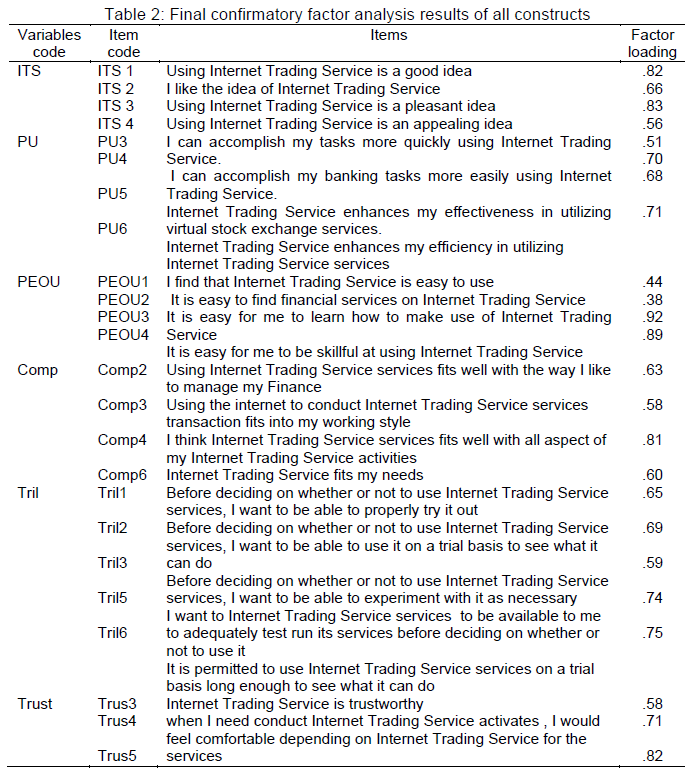 |
 |
Discriminant validity of constructs |
| Discriminant validity refers to observed constructs should not be highly correlated to each other (multicollinearity). In other words, observed variables should be discriminating or distinct (Campbell and Fiske, 1959). To support discriminant validity, average variance extracted (AVE) should be more than the correlation squared (Fornell and Larcker, 1981). Table 3 shows the result of the calculated variance extracted (VE) to support discriminant validity of constructs. Average variance extracted (AVE) is the average VE values of two constructs (Table 3). The VE is derived from the calculation of variance extracted using the following equation: |
 |
| Consequently, each AVE value (Table 3) is found to be more than correlation square (Table 4), thus discriminate validity is supported i.e. multicollinearity is absent. |
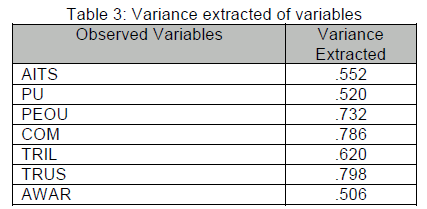 |
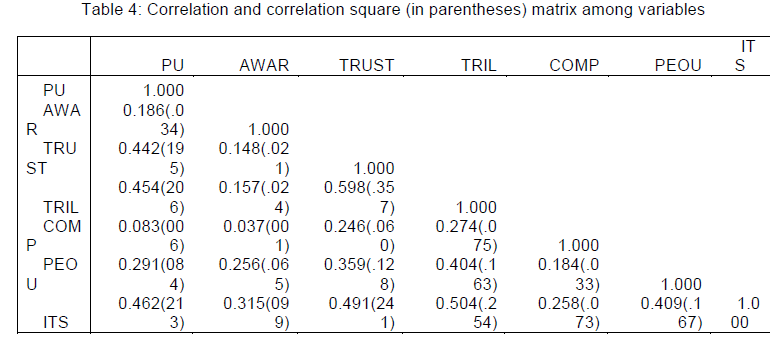 |
Goodness of fit indices |
| Confirmatory factor analysis was conducted on each individual construct and measurement models (see Table 5). All CFAs of constructs produced a relatively good fit as indicated by the goodness of fit indices such as CMIN/df ratio (<2); p-value (>0.05); Goodness of Fit Index (GFI) of >.95; and root mean square error of approximation (RMSEA) values of less than .08 (<.08) (Hair et al., 2006; Bagozzi and Yi, 1988). Table 6 shows the goodness of fit of generated or re-specified structural model is better compared to the hypothesized model. |
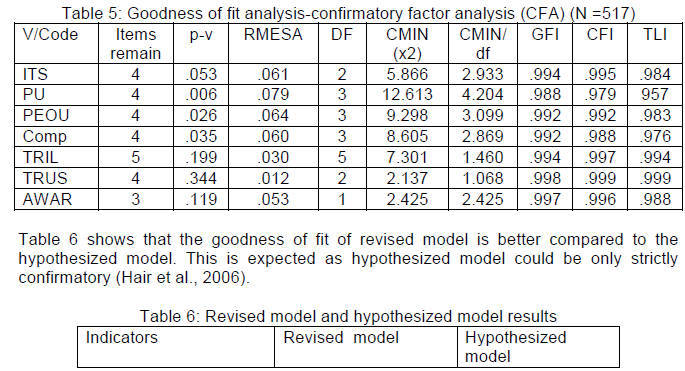 |
 |
Hypotheses results |
| Since the hypothesized model did not achieve model fit (p<.000), therefore, the explanation of hypotheses result is based on Revised Model (RM) which achieved model fit of p-value=0.064 (> 0.05) (Figure 3). The revised model produces regression standardized estimates direct effects readings (Beta) as shown in Table 7. All hypotheses are supported i.e. all direct paths are significant and positive (C.R. values > +/-1.96; p-value < 0.05). |
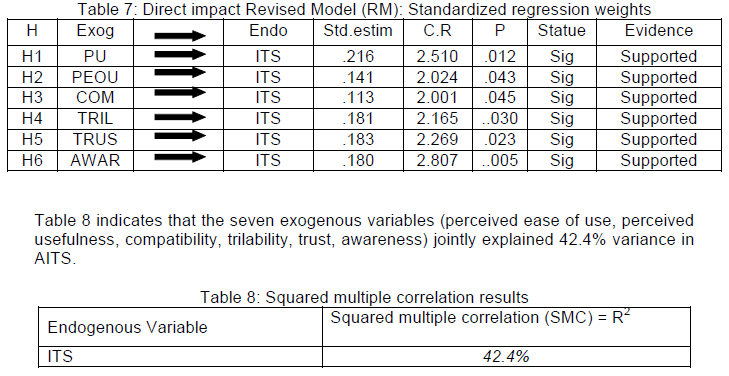 \ \ |
DISCUSSION |
| This study is concerned with an empirical investigation predictors of attitude toward using of Internet Trading Service that could affect a successful predictors of attitude toward using of Internet Trading Service in Jordan through Applications of Innovation Diffusion Theory IDT). The Revised Model (RM) indicates that the IDT has accomplished model fit and supports all six direct paths. |
| As hypothesized (H1), perceived usefulness was found to have a significant positive effect on attitude toward using of Internet Trading Service (β=.216; CR=2.510; p=.012). A large standardized coefficient as compared to other factors suggests its larger contribution in influencing the attitude toward using of Internet Trading Service. This result was supported by several empirical studies in IBS related area (Yiu, Grant and Edgar, 2007; Gounaris and Koritos, 2008; Ozdemir and Trott, 2009). |
| Perceived ease of use (β=.141; CR=2.024; p=.043) was also found to have significant effect on attitude toward using of Internet Trading Service. The finding implies that the Stoke Market Exchange need to make Internet Trading Service easy to use. One interesting aspect the finding shows is that the lower effect of perceived ease of use as compared to perceived usefulness on ITS. The finding of the affects of perceived ease of use on IBSA was put forward by several previous researchers (Prakash and Malik, 2008; Gounaris and Koritos, 2008; Ozdemir and Trott, 2009). |
| The third hypothesis suggests a positive relationship between compatibility and IBSA (β=.113; CR=2.001; p=.045113). The finding shows that compatibility is another success factor that has significant effect on attitude toward using of Internet Trading Service This could mean that the customers perceive the using of Internet Trading Service as new services which accomplish with their existing values and their need. This result is similar to the finding reported in Hernandez and Mazoon, 2007; Eriksson, Kerem and Nilsson, 2008). |
| This study found that trialability has a significant positive effect on the attitude toward using of Internet Trading Service (β=.181; CR=2.165; p=.030). This finding suggests that a positive and successful attitude toward using of Internet Trading Service can be formed if potential users have the opportunity to test-drive the technology. To encourage the acceptance, Stoke Market Exchange should allow potential customers to try Internet Trading Service by providing step-by-step demonstration on how to use Internet Trading Service on their website. This result is consistent with previous result in past study (Hernandez and Mazoon, 2007). |
| Perceived trust was found to have significant effect on (β=.183; CR=2.269; p=.023). This finding confirms that the Internet Trading Service customers in Jordan were trusting in Internet Trading Service, but the Stoke Market Exchange need to develop strategies that could improve the customers trust in the underlying technology. Strategies may include development of security technology, embracing encryption and firewall technology and working closely with online security firms. This may reduce the perception of Internet Trading Service as uncertain and unsafe. Previous finding support the findings of this study (Yu and Lo, 2006; Guerrero, Egea and Gonzalez, 2007; Padachi, Rojid and Seetanah, 2008). |
| Finally, this study shows that awareness is the most important factors that has a positive and significant effect on attitude toward using of Internet Trading Service (β=.180; CR=2.807; p=.005). Awareness appears to be a very important factor among the seven factors probably because Stoke Market Exchange need to practice more promotion and awareness campaign through media advertising and pamphlets. This will encourage the customers to adopt Internet Trading Service efficiently and more frequently in Jordan. Similar finding were obtained by Sohail and Shanmugham (2003) who found that the awareness of Internet Trading Service will increase the success of Internet Trading Service offered. |
CONCLUSION |
| This paper aims to develop new model based on Innovation Diffusion theory (IDT) (Rogers, 1983), by investigating the factors that could encourage the customers to adopt Internet Trading Service in Jordan. All six variables in this study (perceived ease of use, perceived usefulness, compatibility, trialability, trust, awareness) were found to have significant effect on attitude toward using of Internet Trading Service , which could suggest that these could be the key success factors for Internet Trading Service using in Jordan. |
| The main strengths of this study are its derivation of its factors from previous conceptual and empirical research by focusing on that factors that have the most significant effects on attitude toward using of Internet Trading Service area. Future studies could investigate other factors such as self-efficacy and the services quality. It could also extend to the usage of other underpinning theories such as Technology Acceptance Model (TAM) or Theory of Planned behavior (TPB). The study could also extend to include other countries operating in similar conditions to see if comparable results could be achieved. |
References |
|
Copyright © 2024 Research and Reviews, All Rights Reserved